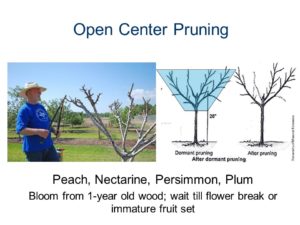Fruit trees in our urban orchards are beginning to show signs of annual growth, and it is now time to prune and shape them. Annual pruning of your established fruit trees is a must for several reasons: pruning enhances tree productivity, maintains a balanced framework to support fruit development, increases new growth for next year’s production and can improve local environmental conditions such as enhance air circulation and light penetration through the canopy. Pruning fruit trees is a worthy effort that requires attention, and I will share a glimpse of two pruning forms that are commonly used in orchard management.
I will start with terminology you may read from a fact sheet, or hear from an experienced orchardist. Two types of pruning cuts are called thinning and heading. Thinning is the removal of entire branches and stems to its point of origin at a larger branch or tree trunk, minimizing overall tree size and enhancing structure. Thinning can also selectively cull fruit, lightening the load and promoting development of larger fruit, as well as creating a structure where fruit weight is evenly distributed throughout the canopy. Heading cuts inhibit apical dominance, which is growth concentrated at the tip of a central stem over growth of lateral buds. Once committed, heading cuts support shoot development along the side of a branch and below the cut.
Pruning is committed in late winter (end of February, beginning of March) at a time when the trees are growing out of dormancy. Strategic heading and thinning encourages bud expression and vegetative growth. I have had an experienced orchardist tell me to prune peach trees just as the branches begin to blush; prune when the pink petals of the tree show through opening buds as they emerge from dormancy.
 The two primary forms used for different types of fruiting trees are called central leader and open canopy. Central leader is a pruning form used for pear, plum, persimmon and apple trees. The habit of these kind of fruit trees is to sprout branches with vertical growth, and shaping uses a combination of targeted heading cuts and limb spreaders such as wood shims or weights tied in the middle of a supple scaffold branch to force it into a lateral structure. The form looks like a pyramid, and you will maintain a central trunk combined with heading cuts to encourage lateral branches that maintain a scaffold structure.
The two primary forms used for different types of fruiting trees are called central leader and open canopy. Central leader is a pruning form used for pear, plum, persimmon and apple trees. The habit of these kind of fruit trees is to sprout branches with vertical growth, and shaping uses a combination of targeted heading cuts and limb spreaders such as wood shims or weights tied in the middle of a supple scaffold branch to force it into a lateral structure. The form looks like a pyramid, and you will maintain a central trunk combined with heading cuts to encourage lateral branches that maintain a scaffold structure.
 Open center pruning is committed to stone fruit like peaches and nectarines. The goal is to create a structure with an open center and scaffold branches forming a vase shape. A combination of heading and thinning cuts are used to maintain each form.
Open center pruning is committed to stone fruit like peaches and nectarines. The goal is to create a structure with an open center and scaffold branches forming a vase shape. A combination of heading and thinning cuts are used to maintain each form.
This article is written as an overview of pruning forms for established trees, and an opportunity for you to begin further research on your own for successful home orchard maintenance. Texas A&M AgriLife Aggie Horticulture provides outstanding articles and fact sheets on individual fruit, nut and citrus varieties online: aggie-horticulture.tamu.edu/fruit-nut/, including planting new trees and annual maintenance scheduling and implementation. Brazoria County residents can continue to enjoy and cultivate information from our Brazoria County AgriLife Horticulture website for info about upcoming programs: https://brazoria.agrilife.org/horticulture/, you can always email me directly with any gardening questions at: sbrueggerhoff@tamu.edu, and I look forward to seeing you in the garden.
